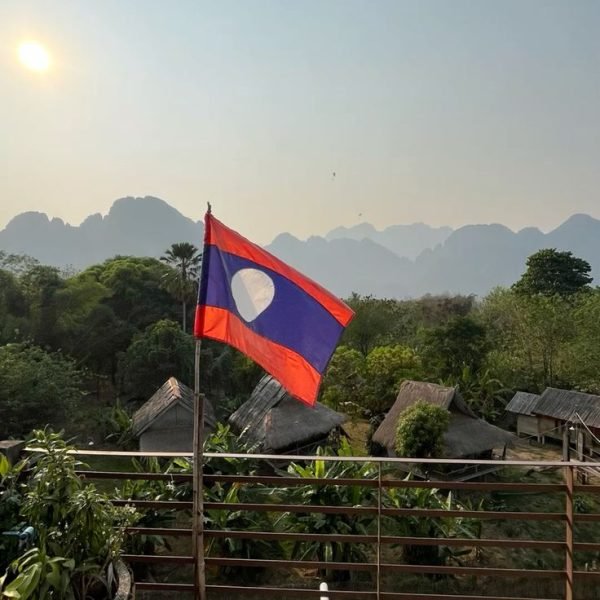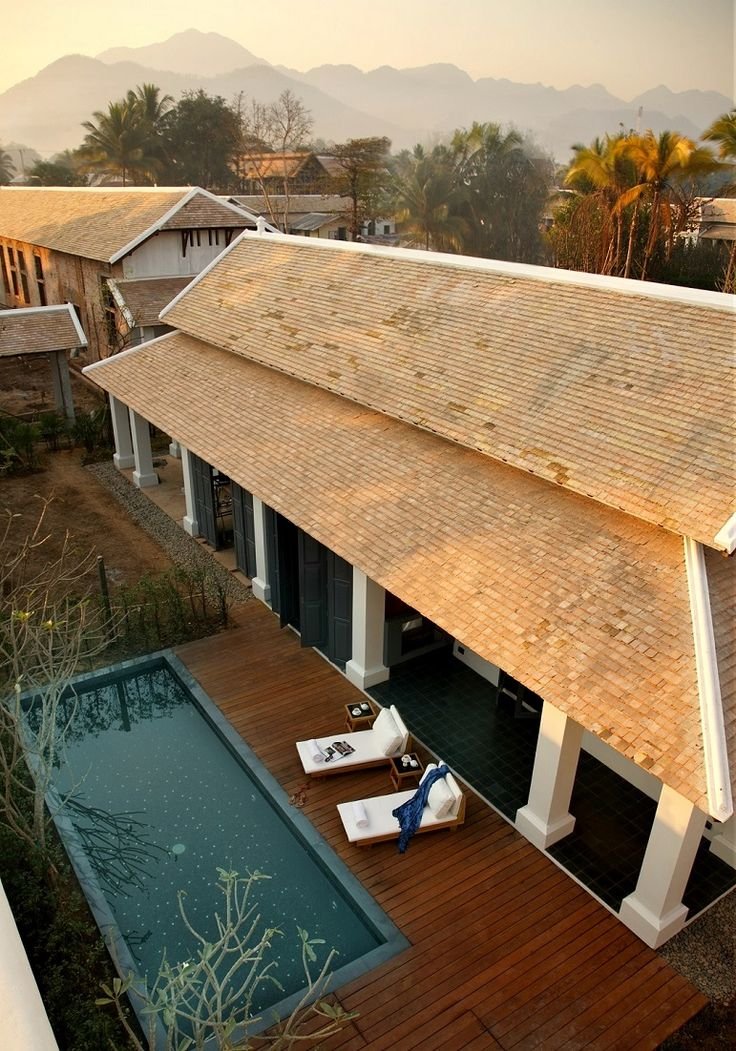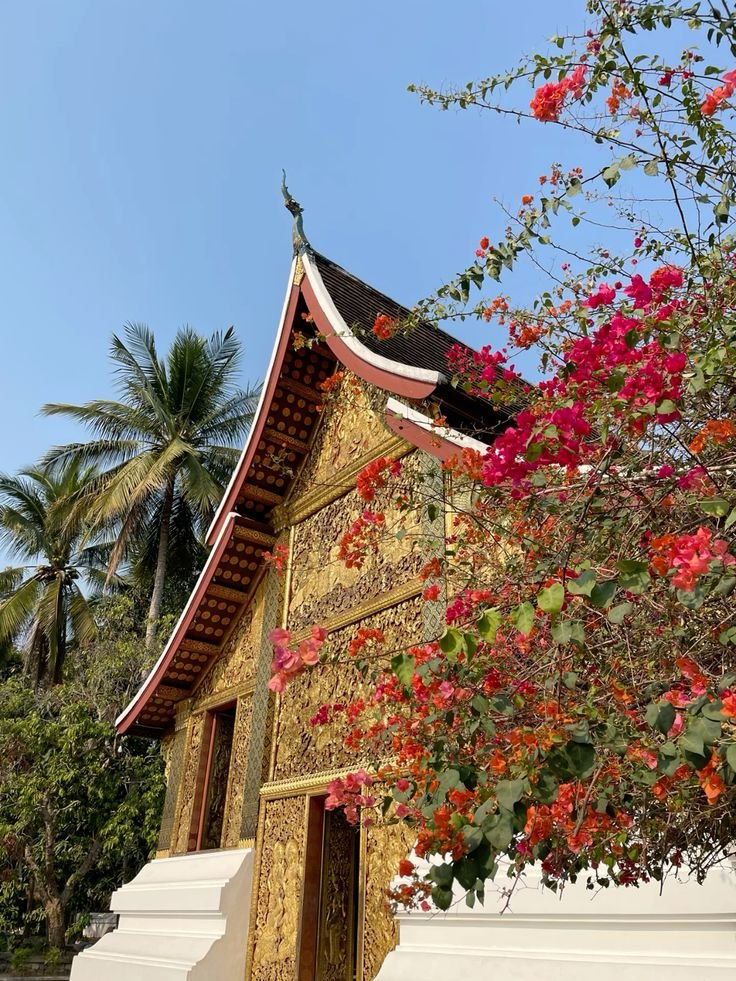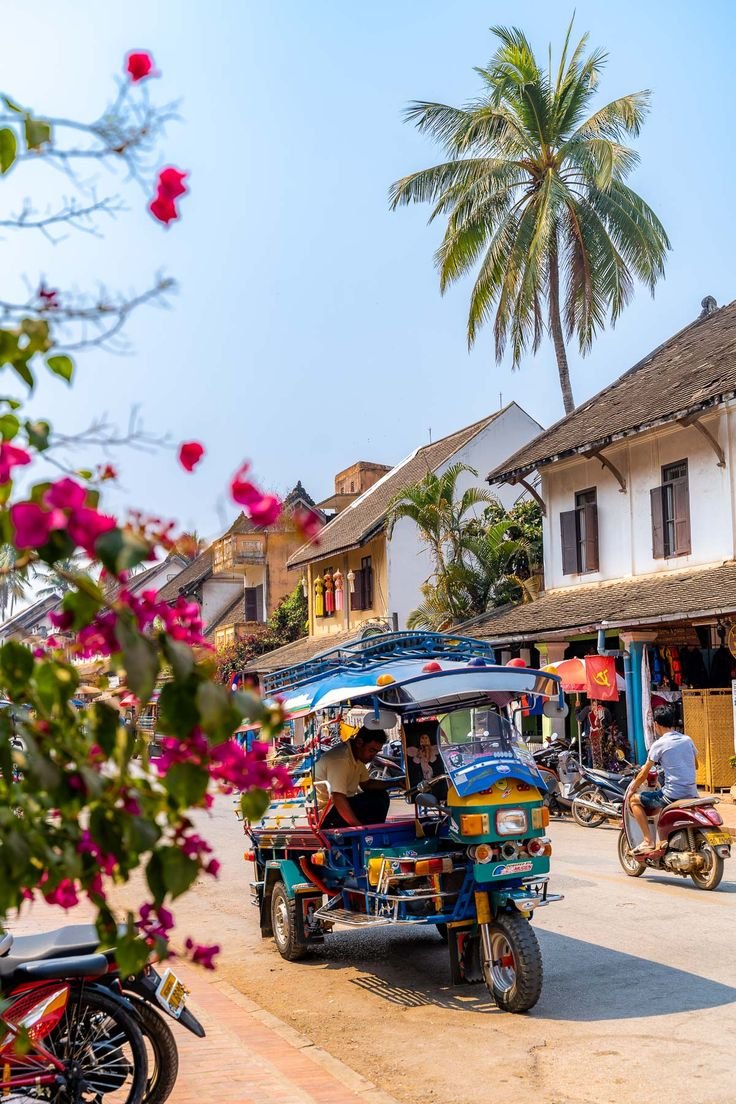Laos
Welcome to Laos
Laos, a landlocked country in Southeast Asia, is a captivating destination known for its stunning natural landscapes, rich cultural heritage, and serene Buddhist traditions. Nestled between Thailand, Vietnam, China, Cambodia, and Myanmar, Laos offers a slower pace of life, where travelers can immerse themselves in lush jungles, majestic mountains, and the winding Mekong River.
The country’s charm lies in its unspoiled beauty, ancient temples, and warm, welcoming people. Despite being less visited than its neighbors, Laos is rapidly gaining popularity for its authentic experiences, from spiritual rituals to thrilling outdoor adventures.
1.
Authentic Cultural Experience: Laos remains refreshingly untouristed compared to other Southeast Asian countries, providing a genuine connection to local life, traditions, and spirituality. Visitors can witness the daily alms-giving ceremony with saffron-robed monks, explore ancient temples, and enjoy vibrant night markets filled with handicrafts and local cuisine.

2.
Natural Beauty and Adventure: The country’s mountainous terrain and river landscapes offer abundant opportunities for adventure travelers. Activities like zip-lining, kayaking, cave tubing, trekking, and hot air ballooning are popular, especially in places like Vang Vieng and the 4,000 Islands. The peaceful countryside and pristine waterfalls, such as Kuang Si Falls, add to the allure of Laos as a nature lover’s paradise.

Planning Your Trip
Visa Information
Travelers to Laos generally need a visa, which can be obtained through Laotian embassies or consulates before arrival. Many nationalities are eligible for a visa on arrival or can apply for an e-Visa online. A valid passport with at least six months’ validity is required for entry. Some countries are exempt from visa requirements, but it is essential to check the latest regulations before traveling to ensure a smooth entry process.
Best Time to Visit
The ideal time to visit Laos is during the dry season, which runs from November to early April. This period offers pleasant weather with cooler temperatures and minimal rainfall, perfect for sightseeing and outdoor activities. The wet season, from May to October, brings heavy rains that can make travel difficult but also transforms the landscape into lush greenery and fills waterfalls to their fullest, appealing to some nature enthusiasts.
Getting To and Around
- Getting There: Laos is accessible by air, with international flights arriving mainly at Wattay International Airport in Vientiane, Luang Prabang International Airport, and Pakse International Airport. Overland travel is also possible via borders with Thailand, Vietnam, Cambodia, and China, making it convenient for travelers exploring the region by road.
- Getting Around: Within Laos, transportation options include buses, minivans, tuk-tuks, motorbike rentals, and riverboats. The country’s mountainous terrain means travel can be slow, but it also offers scenic routes. For longer distances, domestic flights are available between major cities. Exploring by bicycle or motorbike is popular in smaller towns and rural areas, allowing travelers to experience Laos at a relaxed pace.

Accommodation
Laos offers a diverse range of accommodation options that cater to all types of travelers, from budget backpackers to luxury seekers. The country’s lodging scene is characterized by charm, local hospitality, and a strong connection to its natural and cultural surroundings rather than large international hotel chains.
Accommodation Options
Budget Stays
For travelers on a budget, Laos is a haven of affordable guesthouses and homestays. These family-run establishments are widespread in backpacker hotspots like Luang Prabang, Vang Vieng, and the 4,000 Islands. Prices typically range from $10 to $25 per night. Rooms are simple, often equipped with a fan or air conditioning, mosquito nets, and basic furnishings. Bathrooms may be shared, and plumbing can be rustic, but the warm welcome and local insights you receive make up for the simplicity. Many guesthouses offer communal kitchens, riverside views, and complimentary breakfast staples like banana pancakes, creating an authentic and cozy experience.
Riverside Bungalows and Nature Retreats
A quintessential Lao experience is staying in riverside bungalows, especially popular in scenic spots such as Nong Khiaw and the 4,000 Islands. These accommodations, often built from bamboo or wood, provide rustic but charming lodgings with private porches or hammocks overlooking the Mekong River or rice paddies. Prices start around $15 per night. While these bungalows are basic and may lack soundproofing, they offer unbeatable sunrise views and the soothing sounds of nature, perfect for travelers seeking tranquility and immersion in the countryside.
Mid-Range Accommodations
Mid-range options, costing between $30 and $80 per night, strike a balance between comfort and local character. These might include teakwood villas in Luang Prabang, jungle lodges powered by solar energy in the north, or riverfront resorts in Champasak with bicycles for guest use and sunset cocktail services. These accommodations typically offer private bathrooms, reliable Wi-Fi, and hearty breakfasts featuring local specialties such as sticky rice. The ambiance remains intimate and authentic, often blending traditional Lao architecture with modern comforts.
Luxury Hotels and Resorts
Luxury accommodation in Laos is understated but exquisite, focusing on eco-friendly design, privacy, and seamless integration with nature. Prices start at around $100 per night and rise depending on the exclusivity and amenities. Notable luxury hotels include the Sofitel Luang Prabang, housed in a historic French colonial building with private gardens and an Olympic-size pool; Rosewood Luang Prabang, a riverside sanctuary with villas, a hilltop tent experience, and renowned spa treatments; and Amantaka, a collection of restored colonial buildings offering suites with private pools and personalized wellness services.
These luxury resorts emphasize wellness and relaxation, often featuring spa treatments inspired by ancient Lao rituals, farm-to-table dining, and serene natural surroundings. While you won’t find flashy marble lobbies or butlers, the focus on quiet elegance and authentic cultural immersion makes these stays truly special.
Unique Stays
Laos also offers ecolodges and boutique hotels that emphasize sustainability and local craftsmanship. Many of these are small-scale and locally run, providing guests with personalized service and opportunities to engage with the environment and community. Whether it’s a converted heritage home in Vientiane or a jungle lodge in the northern mountains, these accommodations provide a meaningful and memorable stay.

Food and Drink
Laotian cuisine is a vibrant reflection of the country’s culture and geography, emphasizing fresh ingredients, bold flavors, and communal dining. Eating in Laos is not only about nourishment but also about sharing traditions and social connection.
Staple Foods and Flavors
The cornerstone of Laotian food is sticky rice (khao niaw), which is eaten with almost every meal. It is traditionally served in small woven baskets and eaten by hand, often rolled into small balls to dip into various dishes. Alongside sticky rice, you’ll find a variety of grilled meats, fresh herbs, and spicy dips.
Popular dishes include:
Larb: A flavorful minced meat salad (often pork, chicken, or beef) mixed with lime juice, fish sauce, chili, and fresh herbs like mint and cilantro. It is considered the national dish of Laos.
Tam Mak Hoong: The Laotian version of green papaya salad, which is spicier and more pungent than its Thai counterpart, often featuring fermented fish sauce for added depth.
Or Lam: A hearty, spicy stew made with meat, eggplant, wood ear mushrooms, and local herbs, thickened with sticky rice powder.
Khao Piak Sen: A comforting noodle soup with thick rice noodles, chicken or pork broth, and fresh herbs.
Street Food and Markets
Street food is abundant and affordable, especially in cities like Vientiane and Luang Prabang. Markets come alive in the evening with stalls offering grilled skewers, fresh spring rolls, fried insects for the adventurous eater, and sweet treats like coconut sticky rice with mango.
Night markets are also great places to try local specialties, shop for handicrafts, and soak up the lively atmosphere. Don’t miss sampling freshly brewed Lao coffee, which is robust and often served with sweetened condensed milk.
Drinks
Laos has a growing reputation for its coffee, particularly from the Bolaven Plateau, where high-altitude plantations produce rich, aromatic beans. Coffee shops serve it traditionally strong and sweet.
Beer Lao is the country’s most famous beverage, a crisp lager that pairs perfectly with spicy food. It is widely available and affordable. For something stronger, Lao lao is a traditional rice whiskey distilled locally and often enjoyed during social gatherings.
Fresh fruit juices, herbal teas, and coconut water are also popular, providing refreshing options in the tropical climate.
Dining Experiences
Dining in Laos is often a communal affair, with dishes shared around a central platter. Many restaurants, from street stalls to upscale eateries, emphasize fresh, locally sourced ingredients and traditional cooking methods.
In Luang Prabang and Vientiane, you’ll find a range of dining options, including French-inspired cuisine reflecting the country’s colonial history, alongside authentic Lao dishes. Some luxury hotels and resorts offer farm-to-table experiences, where guests can learn about local agriculture and enjoy meals prepared with organic ingredients.

Must-See Attractions
Laos is a treasure trove of natural beauty, cultural heritage, and spiritual sites that captivate every traveler. Here are some of the top must-see attractions to include in your 2025 itinerary:
- Luang Prabang – The Cultural Heart of Laos
A UNESCO World Heritage Site, Luang Prabang is the quintessential Lao city, where traditional Buddhist culture blends seamlessly with French colonial architecture. The town is nestled between the Mekong and Nam Khan rivers, surrounded by lush hills.
- Wat Xieng Thong: This 16th-century temple is one of Laos’s most important and beautiful religious sites. Its intricate mosaics, sweeping roofs, and golden facades make it a must-visit for its architectural splendor and spiritual ambiance.
- Royal Palace Museum: Once the residence of the Lao royal family, the museum offers fascinating insights into the country’s history through royal artifacts, religious objects, and gifts from foreign dignitaries.
- Mount Phousi: Climb 328 steps to this central hill for panoramic views of Luang Prabang and the Mekong River. Sunrise and sunset are especially magical times to visit.
- Pak Ou Caves: Located just outside Luang Prabang, these caves are filled with thousands of Buddha statues in various sizes and styles, accessible by a scenic boat ride along the Mekong River.
- Alms-Giving Ceremony: At dawn, witness the serene ritual of saffron-robed monks collecting alms from locals and tourists—a profound cultural experience unique to Luang Prabang.
- Kuang Si Waterfalls
Just a short drive from Luang Prabang, Kuang Si Falls is a breathtaking natural wonder. The multi-tiered waterfall cascades into turquoise pools perfect for swimming and picnicking. The surrounding jungle offers hiking trails and a bear conservation center where rescued Asiatic black bears are cared for, adding a conservation aspect to your visit.
- Vang Vieng – Adventure and Scenic Beauty
Once known primarily for its party scene, Vang Vieng has transformed into an adventure capital surrounded by dramatic limestone karst mountains and the Nam Song River.
- Blue Lagoons: Cool off in these stunning natural pools with crystal-clear water.
- Hot Air Ballooning: Soar over the karst landscape at sunrise for unforgettable views.
- Kayaking and Tubing: Float or paddle down the Nam Song River, enjoying the serene scenery.
- Hiking and Caving: Explore caves like Tham Phu Kham and hike to viewpoints such as Nam Xay for spectacular vistas.
- The 4,000 Islands (Si Phan Don)
Located in the southern Mekong River near the Cambodian border, this archipelago is ideal for relaxation and slow travel. The islands offer laid-back vibes, cycling paths, waterfalls, and opportunities to spot the rare Irrawaddy dolphins. Don Det and Don Khon are popular islands for visitors seeking tranquility and natural beauty.
- Pakse and the Bolaven Plateau
Pakse serves as a gateway to the Bolaven Plateau, a region known for its cool climate, coffee plantations, and stunning waterfalls like Tad Fane and Tad Yuang. The plateau’s lush landscapes are perfect for motorbike loops and trekking. Nearby, the ancient Khmer temple complex of Wat Phou, older than Angkor Wat, offers a fascinating glimpse into Laos’s historical ties with the Khmer Empire.
- Plain of Jars
This mysterious archaeological site in Xieng Khouang Province features thousands of large stone jars scattered across the landscape. Their origin and purpose remain a mystery, adding an intriguing element to any visit. The area also offers beautiful rural scenery and opportunities to learn about local history.
- Vientiane – The Capital’s Highlights
Though smaller and quieter than many capitals, Vientiane has several notable attractions:
- Pha That Luang: The national symbol of Laos, this golden stupa is a sacred Buddhist monument.
- Wat Si Saket: The oldest surviving temple in Vientiane, famous for its cloister wall filled with thousands of tiny Buddha images.
- Patuxai: Known as the Victory Gate, this war monument offers panoramic views from its rooftop.
- COPE Visitor Centre: An educational center highlighting Laos’s history with unexploded ordnance and the ongoing efforts to assist victims.

Must-Do Activities
Beyond sightseeing, Laos offers a rich variety of activities that allow travelers to engage deeply with its culture, nature, and adventure.
- Participate in the Alms-Giving Ceremony
Start your day early in Luang Prabang by witnessing or respectfully participating in the alms-giving ritual. This spiritual practice involves monks walking silently through the streets to collect food offerings. Visitors can buy sticky rice or pre-packaged offerings from local vendors to contribute. It’s a humbling and unforgettable cultural experience.
- Explore the Mekong River by Boat
The Mekong River is the lifeblood of Laos, and exploring it by boat is a must. Take a slow boat from Luang Prabang to Huay Xai or cruise to the Pak Ou Caves. The river journey offers stunning views of rural life, limestone cliffs, and floating villages.
- Trekking and Village Visits
Northern Laos is renowned for its trekking opportunities through jungle-covered hills and ethnic minority villages. Guided treks from Luang Namtha or Luang Prabang allow you to meet hill tribes, learn about traditional crafts, and experience rural Lao life firsthand.
- Ziplining and the Gibbon Experience
For thrill-seekers, the Gibbon Experience in Bokeo Nature Reserve offers an extraordinary adventure. Stay overnight in treehouses and zipline through the forest canopy, spotting gibbons and other wildlife in their natural habitat.
- Kayaking and Tubing
In Vang Vieng and along the Nam Ou River, kayaking and tubing are popular ways to enjoy the stunning karst landscapes and cool off in the water. These activities range from relaxing floats to more active paddling adventures.
- Visit Elephant Sanctuaries
Laos is known as the “Land of a Million Elephants,” and ethical elephant sanctuaries offer opportunities to learn about and interact with these majestic creatures in a responsible way. Sanctuaries near Luang Prabang and Pakse focus on rescue and rehabilitation.
- Attend a Cooking Class
Lao cuisine is fresh, flavorful, and unique. Taking a cooking class in Luang Prabang or Vientiane is a fantastic way to learn about local ingredients and culinary traditions. Many classes include visits to local markets, hands-on preparation, and tasting sessions.
- Experience Local Festivals
If your travel dates coincide, participating in Lao festivals adds a rich layer to your experience. The Lao New Year (Pi Mai) in April is famous for its water fights and joyful celebrations. Other important festivals include That Luang Festival in Vientiane and boat races during the rainy season.
- Relax at Hot Springs and Waterfalls
Natural hot springs near Vang Vieng and Pakse provide soothing spots to unwind after days of trekking or exploring. Waterfalls like Kuang Si near Luang Prabang and Tad Fane on the Bolaven Plateau are perfect for swimming and picnicking.
- Explore Night Markets
Evenings in Luang Prabang and Vientiane come alive with night markets offering handicrafts, textiles, souvenirs, and street food. These markets are ideal for finding unique gifts and tasting local snacks while soaking in the lively atmosphere.

Travel Tips
Traveling to Laos in 2025 promises an enriching experience filled with stunning landscapes, vibrant culture, and warm hospitality. To ensure your journey is safe, respectful, and enjoyable, here is a comprehensive guide covering essential safety advice, local customs, and basic language tips.
Safety Advice
Laos is generally a welcoming and safe country for travelers, but like any destination, it requires awareness and preparation to avoid common risks and enjoy your trip fully.
General Safety
- Low Crime but Stay Alert: Petty crime such as pickpocketing and bag snatching can occur, especially in busy tourist areas like Luang Prabang, Vientiane, and Vang Vieng. Avoid carrying large amounts of cash or valuables, keep your belongings secure, and stay vigilant in crowded markets or festivals. Avoid poorly lit or isolated areas at night and always travel with a companion when possible.
- Avoid Risky Border Areas: Some border regions, notably Bokeo Province near Myanmar, have been linked to drug trafficking and organized crime. Exercise caution and avoid traveling to these areas unless with a reputable guide or tour operator.
- Unexploded Ordnance (UXO): Laos is one of the most heavily bombed countries in history, and unexploded bombs remain a danger, particularly near former conflict zones like the Plain of Jars and the Lao-Vietnamese border. Always stay on marked paths, heed local warnings, and avoid venturing into remote or unmarked areas.
Road and Transport Safety
- Road Conditions: Roads outside major cities can be poorly maintained, and driving standards are often below Western norms. Reckless driving, lack of street lighting, and stray animals on roads increase accident risks, especially after dark. Avoid traveling at night and use reputable transportation services.
- Motorbike Rentals: If you rent a motorbike, insist on a helmet and check the vehicle’s condition thoroughly. Many accidents involve inexperienced riders or poorly maintained bikes. Consider hiring a local driver if you’re unfamiliar with the roads.
- Public Transport: Buses and minivans can be overcrowded and sometimes unsafe. Use official and licensed operators. River travel, especially by speedboat on the Mekong, can be dangerous when water levels are low. Always wear life jackets and avoid water activities under the influence of alcohol or drugs.
- Emergency Contacts: Save emergency numbers such as police (1191), ambulance (1195), and tourist police (in Vientiane 21 251 128). In case of serious medical emergencies, nearby Thai hospitals may offer better facilities.
Health Precautions
- Food and Water Safety: Eat at reputable restaurants and avoid street food that looks unhygienic. Drink bottled or purified water only. Use insect repellent to protect against mosquitoes that carry dengue, malaria, and Zika.
- Vaccinations: Consult your doctor before traveling to ensure you have all recommended vaccines. Carry a basic first aid kit and any personal medications.
Local Customs
Understanding and respecting local customs will enrich your experience and help you build positive connections with Lao people.
Respect for Buddhism
- Laos is a deeply Buddhist country, and temples are sacred spaces. Dress modestly when visiting temples—cover shoulders and knees—and remove your shoes before entering.
- Never touch a monk, especially if you are a woman, as physical contact is considered inappropriate.
- Avoid pointing your feet at religious statues, monks, or people, as feet are considered the lowest and least clean part of the body.
- When greeting, the traditional Lao gesture is the nop, where you place your palms together in a prayer-like position and bow slightly. It is polite to return this greeting.
Social Behavior
- Head and Feet: The head is considered the most sacred part of the body, so avoid touching anyone’s head, including children. Feet are considered unclean, so don’t point them at people or religious objects.
- Public Displays of Affection: These are generally frowned upon, especially in rural areas. Keep physical affection discreet.
- Photography: Always ask permission before photographing people, especially monks or ethnic minority groups. Some may refuse, and their wishes should be respected.
- Gift Giving: Small gifts like local handicrafts or food are appreciated if visiting homes or villages. Avoid giving money directly to children, as it can encourage dependency.
Dress Code
- Dress conservatively, especially outside tourist areas. Lightweight, breathable clothing that covers shoulders and knees is ideal.
- In cities, casual wear is accepted, but modesty is still appreciated in religious or rural settings.
Language Basics
The official language is Lao, a tonal language closely related to Thai but with its own script. While English is spoken in tourist areas, learning a few basic Lao phrases will endear you to locals and enhance your interactions.
Common Lao Phrases
- Hello: Sabaidee (ສະບາຍດີ)
- Thank you: Khop chai (ຂອບໃຈ)
- Yes: Jao (ແມ່ນ)
- No: Bor (ບໍ່)
- Please: Khaw thot (ຂໍໂທດ)
- Excuse me / Sorry: Kho thot (ຂໍໂທດ)
- How much?: Tao dai? (ເທົ່າໃດ?)
- Where is…?: Yu nai? (ຢູ່ໃສ?)
- I don’t understand: Bor kow jai (ບໍ່ເຂົ້າໃຈ)
Tips for Communication
- Speak slowly and clearly; Lao is tonal, so pronunciation matters.
- Smiling and polite gestures go a long way in overcoming language barriers.
- Use translation apps or phrasebooks if needed, but locals appreciate any effort to speak Lao.
Final Thoughts
Additional Practical Tips
- Money: Lao kip is the official currency, but US dollars and Thai baht are widely accepted in tourist areas. Carry cash, as card payments are not common outside major cities.
- Internet and Connectivity: Wi-Fi is available in hotels and cafes in cities, but can be patchy in rural areas. Consider purchasing a local SIM card for better connectivity.
- Respect the Environment: Laos is known for its pristine nature. Avoid littering, use refillable water bottles, and support eco-friendly tourism initiatives.
- Cultural Sensitivity: Avoid political discussions or criticism of the government. Respect local traditions and laws, especially regarding drug use, which is strictly illegal and severely punished.
By following these safety guidelines, embracing local customs, and learning a few Lao phrases, you will not only protect yourself but also deepen your connection with this enchanting country. Laos in 2025 invites you to explore its natural beauty and rich culture with respect and care, ensuring your journey is memorable for all the right reasons.

